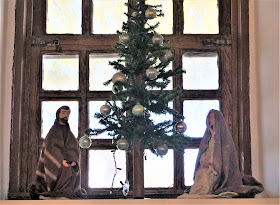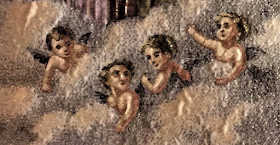December 31, 2018
The last thing we did on our West Texas Adventure was visit three missions on El Paso's El Camino Real (AKA The Royal Road or the Mission Trail). Within less than 10 miles, there are three missions, which makes for a great tourist adventure.
I am used to applying the term "El Camino Real" to the 600-mile-road that connects California's 21 Spanish missions. However, there is a different "Camino Real" that runs from Mexico City through Paso del Norte (now Juarez, Mexico) and the El Paso area, and ending in Santa Fe.
1. Ysleta Mission
Our first stop was at the Ysleta Mission, the oldest continuously operated parish in Texas. It was founded in 1682, but flooding of the Rio Grande destroyed the mission in 1742 and then again in 1829. It was rebuilt for a third time in 1851, and it looked like the third time was the charm (and building it on higher ground didn't hurt either) until a fire wiped out much of the historic mission in 1907. No worries--it was rebuilt the next year.
I loved the "bars" on the windows and the simple wooden door. These mission churches are such a contrast to their ornate cathedrals counterparts.
We enjoyed walking around the grounds, where there is a re-creation of Golgotha and the Garden Tomb ("Garden" being a term used quite loosely in this arid landscape).
The crude crosses back up against a telephone pole that at first glance looks like another cross.
Plastic flower arrangements and plastic bunnies brighten up the unrelenting desert-scape.
The graves seem to be unusually close together, in spite of the vacant land just beyond them.
Each grave has a story. I wish I knew what they were.
Having explored the grounds, we were ready to go inside.
The Socorro Mission was founded by Franciscans in 1682. The present adobe and stucco structure was built around 1840 to replace a previous structure destroyed by the 1829 flooding of the Rio Grande, just like the Ysleta Mission.
On the other hand, it is a little harder to relate to this avenging angel (Michael, the patron saint of the mission) with his scales of justice in one hand and a sword in the other hand and his feet on the heads of children and a dragon.
And I must confess that I was a bit creeped out by this display of the crucified body of Christ, but I recognize that religious practices vary by culture.
3. San Elizario Presidio Chapel
The third chapel we visited is the newest of the three. A Mexican chapel was built on this site in 1790 to serve the military and their families rather than for the purpose of converting the native population. (Therefore, it is not a "mission" but rather a "presidio.") It was named for St. Elzear, the 13th-century French patron of the military. That chapel was destroyed in 1829 by the same flood of the Rio Grand that destroyed the previous two mission chapels in this post.
Imagine what life would have been like that year! Everything had been washed away by the muddy water of the river that had until then played such an important role in sustaining life. Well, a new chapel was quickly built in its place, and then almost 50 years later, a third iteration was completed in 1877.
But then in 1935, an electrical short caused a fire that led to a fairly substantial remodeling, including the pressed tin ceiling that covers up the burnt ceiling beams and neo-classical trim covering up the charred posts.
The three pairs of angels positioned over three arches is my favorite part of the church.
That new tin ceiling was painted by parishioners in 1944 to honor soldiers returning from World War II (which is essentially what the sign that wraps around the rear door says).
In the niche where I am used to seeing an altar and a statue of Mary was a sweet nativity scene. What made it so appealing to me was its imperfections, especially its weird scale issues. For example, that angel is about three times the size of Mary and Joseph.
But that's nothing compared to the out-sized Baby Jesus. I guess size is an indication of who is most important.
Here are the three chapels we visited, side-by-side for comparison: Top row - San Elizario Presidio and Ysleta Mission; bottom - Socorro Mission
The last thing we did on our West Texas Adventure was visit three missions on El Paso's El Camino Real (AKA The Royal Road or the Mission Trail). Within less than 10 miles, there are three missions, which makes for a great tourist adventure.
I am used to applying the term "El Camino Real" to the 600-mile-road that connects California's 21 Spanish missions. However, there is a different "Camino Real" that runs from Mexico City through Paso del Norte (now Juarez, Mexico) and the El Paso area, and ending in Santa Fe.
Our first stop was at the Ysleta Mission, the oldest continuously operated parish in Texas. It was founded in 1682, but flooding of the Rio Grande destroyed the mission in 1742 and then again in 1829. It was rebuilt for a third time in 1851, and it looked like the third time was the charm (and building it on higher ground didn't hurt either) until a fire wiped out much of the historic mission in 1907. No worries--it was rebuilt the next year.
Unfortunately, the little chapel was closed on the day we were there, so we could only walk around the outside.
The bell tower was empty but there was a bell on the ground. It's sure easier to ring that way!
I loved the "bars" on the windows and the simple wooden door. These mission churches are such a contrast to their ornate cathedrals counterparts.
The Virgin of Guadalupe, who appeared to the peasant Juan Diego in 1531, seems to be almost as popular in El Paso as she is in Mexico City, over 1,100 miles away.
2. Socorro Mission
We moved on to the Socorro Mission, just a few miles down El Camino Real. Where the Ysleta Mission is all curves and domes, the Socorro Mission is all about straight lines and right angles.
The crude crosses back up against a telephone pole that at first glance looks like another cross.
The stone (something relatively lightweight wrapped in fabric) is rolled away from the empty tomb.
On another side of the mission are some tombs that are NOT empty. I enjoy walking around cemeteries, and this one made me think of cemeteries attached to churches in the eastern United States. Texas feels like a different country than Virginia or New York.
Plastic flower arrangements and plastic bunnies brighten up the unrelenting desert-scape.
The graves seem to be unusually close together, in spite of the vacant land just beyond them.
Having explored the grounds, we were ready to go inside.
The Socorro Mission was founded by Franciscans in 1682. The present adobe and stucco structure was built around 1840 to replace a previous structure destroyed by the 1829 flooding of the Rio Grande, just like the Ysleta Mission.
The beams from the original church were salvaged and reused in the present building.
I am just as moved by the simplicity of the mission churches as I am by the great cathedrals. This is faith that is easy to relate to.
On the other hand, it is a little harder to relate to this avenging angel (Michael, the patron saint of the mission) with his scales of justice in one hand and a sword in the other hand and his feet on the heads of children and a dragon.
This tapestry shows the Trinity--Father, Son, and Holy Spirit--as three distinct entities.
And how about the cherubs in their bubble bath clouds?
Proof that we were there!
The third chapel we visited is the newest of the three. A Mexican chapel was built on this site in 1790 to serve the military and their families rather than for the purpose of converting the native population. (Therefore, it is not a "mission" but rather a "presidio.") It was named for St. Elzear, the 13th-century French patron of the military. That chapel was destroyed in 1829 by the same flood of the Rio Grand that destroyed the previous two mission chapels in this post.
Imagine what life would have been like that year! Everything had been washed away by the muddy water of the river that had until then played such an important role in sustaining life. Well, a new chapel was quickly built in its place, and then almost 50 years later, a third iteration was completed in 1877.
The tower with its stack of bells was added later
That new tin ceiling was painted by parishioners in 1944 to honor soldiers returning from World War II (which is essentially what the sign that wraps around the rear door says).
Close-up view of the ceiling:
The simple altar and crucifix were decorated with poinsettias when we were there. The three potted poinsettias at the feet of the crucified Christ felt especially appropriate. In Mexico there is a legend that a poor little girl who had nothing to give to the Baby Jesus at Christmas Eve services picked a small handful of weeds from the roadside. When she placed her simple offering at the bottom of the nativity scene, the weeds miraculously burst into bright red flowers whose shape resembles the Star of Bethlehem that led the Wise Men to Jesus and whose red-colored leaves symbolize the blood of Christ.
I love this little chapel to the left of the altar, which I think must usually be the "Mary Chapel" when it isn't the Christmas season. It has angels and the words "Ave Maria" painted above the arch.
A richly brown-skinned portrayal of the Virgin of Guadalupe stands off to one side. That must be the humble peasant Juan Diego under Mary's feet and holding her cape. (The image on the right is the common image for the Virgin of Guadalupe used in Mexico.)
In the niche where I am used to seeing an altar and a statue of Mary was a sweet nativity scene. What made it so appealing to me was its imperfections, especially its weird scale issues. For example, that angel is about three times the size of Mary and Joseph.
On the other side of the main altar is the image of Christ known as the Sacred Heart of Jesus, in which Christ's heart is exposed on his chest as a symbol of his "boundless and passionate love for mankind."
This is a church that likes angels. They are everywhere. These two look like identical twins.
The arches in the nave are repeated in the doors and windows.
On the grounds outside the church is a stone monument, but I'm not sure who the woman is who is praying to Mary.
In true Mexican style, San Elizario has a gathering area complete with a gazebo, much like a zocolo in a Mexican village.
Here are the three chapels we visited, side-by-side for comparison: Top row - San Elizario Presidio and Ysleta Mission; bottom - Socorro Mission
From there we drove to the airport, dropped off our rental car, and flew home to California. And so ended our first foray into West Texas, a mostly positive experience.

























































I missed the empty tomb at Socorro. I really enjoyed this trip along El Camino Real and the wonderful Mexican food restaurant we went to after. Probably my favorite thing in El Paso, other than a couple of really good meals in El Paso.
ReplyDelete